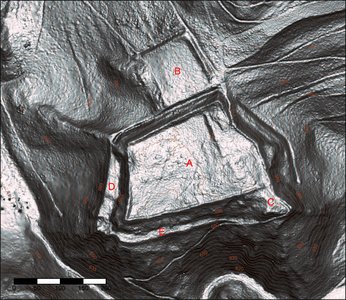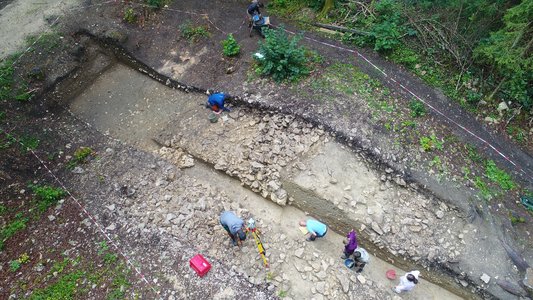The Große Heuneburg – A Mighty Fortification of the Early Celts
About 12 km north of the Heuneburg, near Zwiefalten-Upflamör, at an altitude of 716m above sea level, lies a site of impressive dimensions: the Große Heuneburg. The complex, which lies about 90m above the valley floor, is divided into a main enclosure of about 5 hectares, which is fortified all around, and an annex to the north of about 1.5 hectares. In the southeast, outside the actual fortification, there is a spur of land called the "Flankenburg".
After the first poorly documented investigations at the end of the 19th century, the archaeologist Gerhard Bersu made a total of 40, mostly small exploratory cuts, across the Große Heuneburg in 1921. In 2016 and 2018, two wall sections of the old excavations were extended and re-examined. In the northwest of the main enclosure, a 3.6m thick mortarless two-shell wall came to light, the filling of which consisted of the limestone rubble found on site. The preserved height of the wall was still about 1.6m. A section on the east side of the annex also revealed a two-shell mortarless wall which originally had a maximum thickness of 3.4m. On the inner side, behind the wall, there is an embankment made of marl, which was certainly extracted during the construction of the ditch in front of the annex. A section inside the main enclosure revealed an early medieval building ground plan measuring about 9 x 16m as well as older ditch systems which could date back to the Hallstatt period.
The previous find material from the Große Heuneburg is mainly from the Hallstatt period. There are also some Middle Bronze Age and Urnfield Period artefacts. The modern excavations have been able to prove that the Große Heuneburg was settled and fortified during the Hallstatt period. It is hoped that future excavations will be able to shed more light on its purpose and relationship to the (smaller) Heuneburg.
References: Hansen et al. 2016a; Hansen et al. 2018a.



